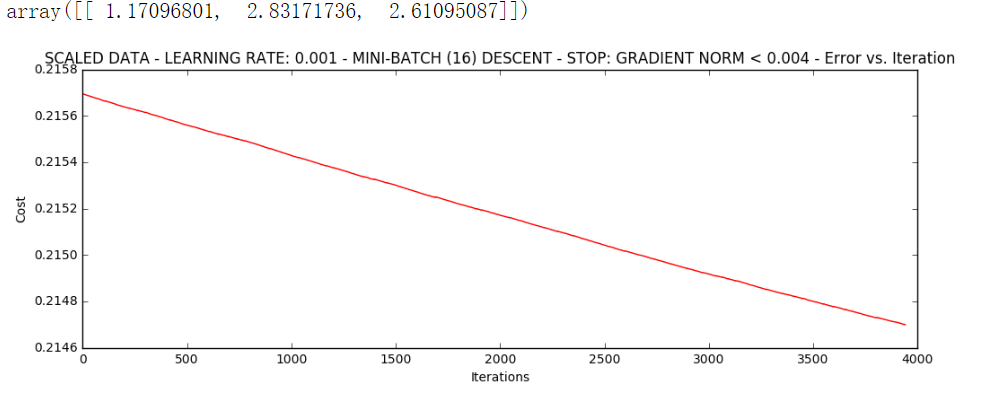目标:
我们将建立一个逻辑回归模型来预测一个学生是否被大学录取。假设你是一个大学系的管理员,你想根据两次考试的结果来决定每个申请人的录取机会。你有以前的申请人的历史数据,你可以用它作为逻辑回归的训练集。对于每一个培训例子,你有两个考试的申请人的分数和录取决定。为了做到这一点,我们将建立一个分类模型,根据考试成绩估计入学概率。
#三大件 import numpy as np import pandas as pd import matplotlib.pyplot as plt
%matplotlib inline
import os
path = 'LogiReg_data.txt'
pdData = pd.read_csv(path, header=None, names=['Exam 1', 'Exam 2', 'Admitted'])
pdData.head()
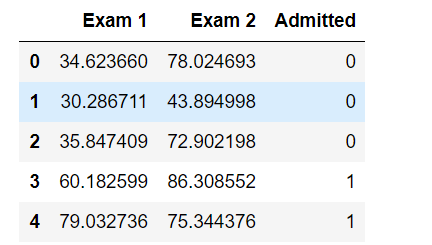
positive = pdData[pdData['Admitted'] == 1] # returns the subset of rows such Admitted = 1, i.e. the set of *positive* examples negative = pdData[pdData['Admitted'] == 0] # returns the subset of rows such Admitted = 0, i.e. the set of *negative* examples fig, ax = plt.subplots(figsize=(10,5)) ax.scatter(positive['Exam 1'], positive['Exam 2'], s=30, c='b', marker='o', label='Admitted') ax.scatter(negative['Exam 1'], negative['Exam 2'], s=30, c='r', marker='x', label='Not Admitted') ax.legend() #将我们传入的数据映射到画图区域中 ax.set_xlabel('Exam 1 Score') ax.set_ylabel('Exam 2 Score')

目标:建立分类器(求解出三个参数 θ0θ1θ2θ0θ1θ2)
设定阈值,根据阈值判断录取结果
要完成的模块
-
sigmoid: 映射到概率的函数 -
model: 返回预测结果值 -
cost: 根据参数计算损失 -
gradient: 计算每个参数的梯度方向 -
descent: 进行参数更新 -
accuracy: 计算精度

def sigmoid(z): return 1 / (1 + np.exp(-z))
Sigmoid
- g:ℝ→[0,1]g:R→[0,1]
- g(0)=0.5g(0)=0.5
- g(−∞)=0g(−∞)=0
- g(+∞)=1g(+∞)=1
def model(X, theta): return sigmoid(np.dot(X, theta.T)) #预测函数 输入参数和两门成绩的特征向量返回预测结果(sigmoid)分类

#第一个参数是没有对应相乘的特征向量的 所以我们需要增加一列为常数1的特征向量与第一个参数相乘 pdData.insert(0, 'Ones', 1) # in a try / except structure so as not to return an error if the block si executed several times # set X (training data) and y (target variable) orig_data = pdData.as_matrix() # convert the Pandas representation of the data to an array useful for further computations(将数据转化为数组) cols = orig_data.shape[1] #shape 返回的是元组 第一个参数是行 第二个是列 X = orig_data[:,0:cols-1] #得到特征向量数据 y = orig_data[:,cols-1:cols] #获取分类,0表示未录取 1表示录取了 # convert to numpy arrays and initalize the parameter array theta #X = np.matrix(X.values) #y = np.matrix(data.iloc[:,3:4].values) #np.array(y.values) theta = np.zeros([1, 3]) #队参数进行占位操作

def cost(X, y, theta): left = np.multiply(-y, np.log(model(X, theta))) right = np.multiply(1 - y, np.log(1 - model(X, theta))) return np.sum(left - right) / (len(X))
#cost(X, y, theta) ----0.69314718055994529

def gradient(X, y, theta):
grad = np.zeros(theta.shape)
error = (model(X, theta)- y).ravel() #.reval()改变矩阵的维度 变成一维向量
for j in range(len(theta.ravel())): #for each parmeter #循环每个特征向量 对每个权重参数进行梯度求解
term = np.multiply(error, X[:,j]) #误差和 每行特征向量相乘 得到每个参数的梯度
grad[0, j] = np.sum(term) / len(X)
return grad #返回每个参数的梯度下降的

STOP_ITER = 0 STOP_COST = 1 STOP_GRAD = 2 def stopCriterion(type, value, threshold): #设定三种不同的停止策略 if type == STOP_ITER: return value > threshold elif type == STOP_COST: return abs(value[-1]-value[-2]) < threshold elif type == STOP_GRAD: return np.linalg.norm(value) < threshold
import numpy.random #洗牌 :可能收集的信息是按照一定的顺序 为了使模型发泛化能力更强 所以我们先把信息顺序打乱 def shuffleData(data): np.random.shuffle(data) #洗牌 cols = data.shape[1] #列 X = data[:, 0:cols-1] #特征向量 y = data[:, cols-1:] #分类向量 return X, y
import time def descent(data, theta, batchSize, stopType, thresh, alpha): #梯度下降求解 init_time = time.time() #得到的是时间戳 i = 0 # 迭代次数 k = 0 # batch X, y = shuffleData(data) #洗牌 grad = np.zeros(theta.shape) # 计算的梯度,先给参数占位子, costs = [cost(X, y, theta)] # 计算平均损失值数组,每次迭代之后(梯度下降之后)新的损失值 while True: grad = gradient(X[k:k+batchSize], y[k:k+batchSize], theta) k += batchSize #取batch数量个数据 批量大小 if k >= n: #n是迭代的次数 k = 0 X, y = shuffleData(data) #重新洗牌 theta = theta - alpha*grad # 参数更新 costs.append(cost(X, y, theta)) # 计算新的损失 i += 1 if stopType == STOP_ITER: value = i elif stopType == STOP_COST: value = costs elif stopType == STOP_GRAD: value = grad if stopCriterion(stopType, value, thresh): break return theta, i-1, costs, grad, time.time() - init_time
def runExpe(data, theta, batchSize, stopType, thresh, alpha): #import pdb; pdb.set_trace(); theta, iter, costs, grad, dur = descent(data, theta, batchSize, stopType, thresh, alpha) ##descent()梯度下降求解 name = "Original" if (data[:,1]>2).sum() > 1 else "Scaled" name += " data - learning rate: {} - ".format(alpha) if batchSize==n: strDescType = "Gradient" elif batchSize==1: strDescType = "Stochastic" else: strDescType = "Mini-batch ({})".format(batchSize) name += strDescType + " descent - Stop: " if stopType == STOP_ITER: strStop = "{} iterations".format(thresh) elif stopType == STOP_COST: strStop = "costs change < {}".format(thresh) else: strStop = "gradient norm < {}".format(thresh) name += strStop print ("***{} Theta: {} - Iter: {} - Last cost: {:03.2f} - Duration: {:03.2f}s".format( name, theta, iter, costs[-1], dur)) fig, ax = plt.subplots(figsize=(12,4)) ax.plot(np.arange(len(costs)), costs, 'r') ax.set_xlabel('Iterations') ax.set_ylabel('Cost') ax.set_title(name.upper() + ' - Error vs. Iteration') return theta
不同的停止策略
1.设定迭代次数
#选择的梯度下降方法是基于所有样本的 n=100 runExpe(orig_data, theta, n, STOP_ITER, thresh=5000, alpha=0.000001)

2.根据损失值停止:设定阈值 1E-6, 差不多需要110 000次迭代
runExpe(orig_data, theta, n, STOP_COST, thresh=0.000001, alpha=0.001)

3.根据梯度变化停止:设定阈值 0.05,差不多需要40 000次迭代
runExpe(orig_data, theta, n, STOP_GRAD, thresh=0.05, alpha=0.001)
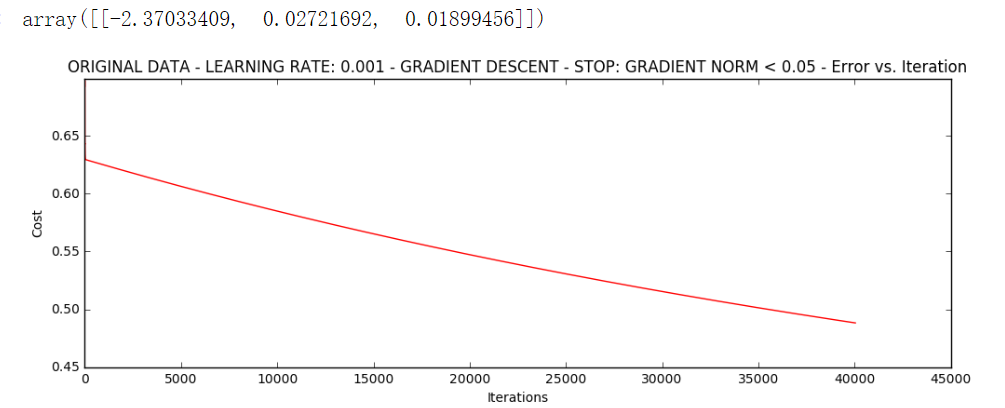
对比不同的梯度下降方法
runExpe(orig_data, theta, 1, STOP_ITER, thresh=5000, alpha=0.001)

发现:有点爆炸。。。很不稳定,再来试试把学习率调小一些
runExpe(orig_data, theta, 1, STOP_ITER, thresh=15000, alpha=0.000002)
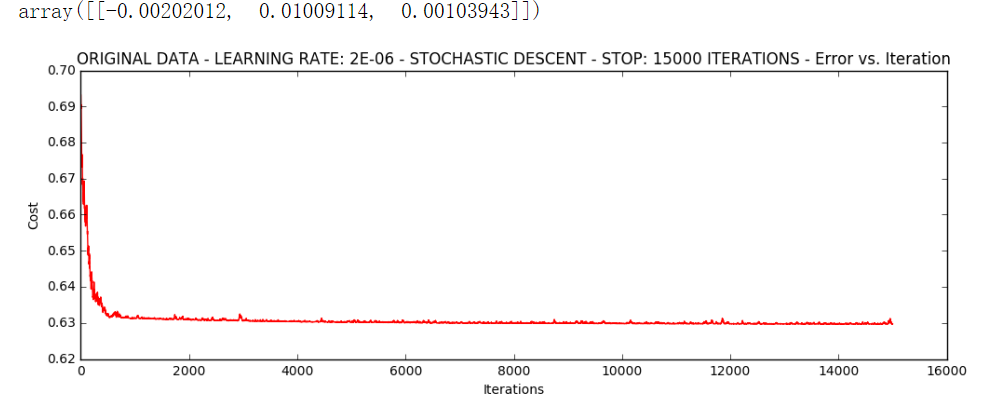
发现:速度快,但稳定性差,需要很小的学习率
runExpe(orig_data, theta, 16, STOP_ITER, thresh=15000, alpha=0.001)
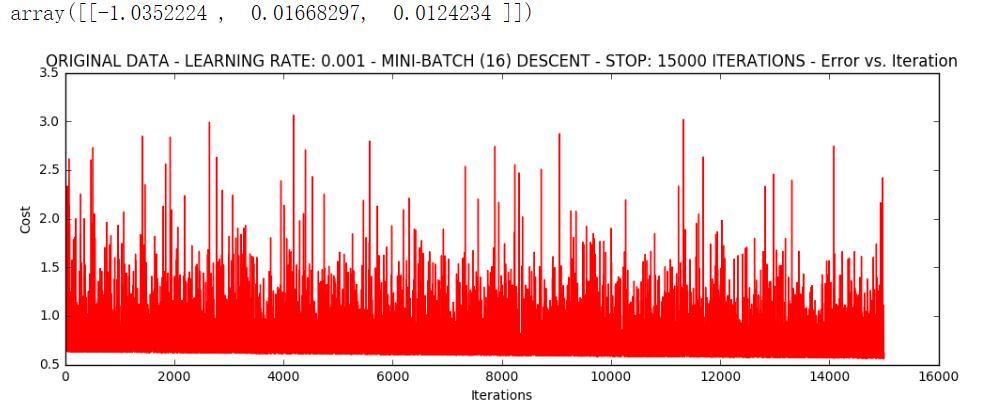
发现:浮动仍然比较大,我们来尝试下对数据进行标准化 将数据按其属性(按列进行)减去其均值,然后除以其方差。
最后得到的结果是,对每个属性/每列来说所有数据都聚集在0附近,方差值为1
from sklearn import preprocessing as pp scaled_data = orig_data.copy() scaled_data[:, 1:3] = pp.scale(orig_data[:, 1:3]) runExpe(scaled_data, theta, n, STOP_ITER, thresh=5000, alpha=0.001)
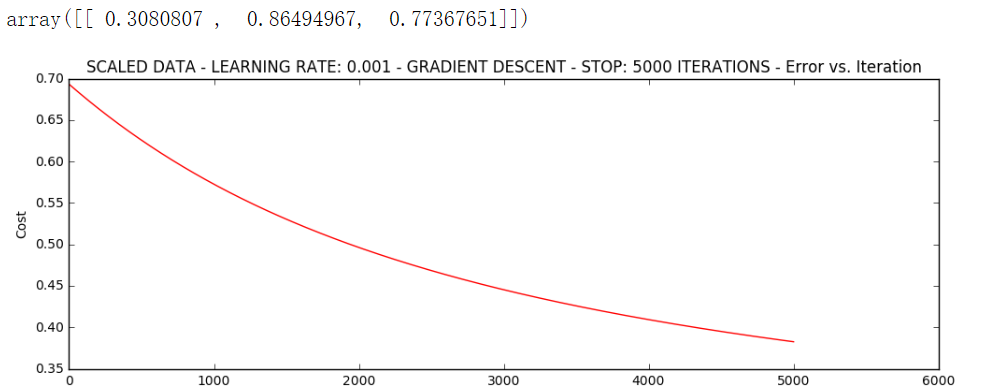
发现:它好多了!原始数据,只能达到达到0.61,而我们得到了0.38个在这里! 所以对数据做预处理是非常重要的
runExpe(scaled_data, theta, n, STOP_GRAD, thresh=0.02, alpha=0.001)

发现:更多的迭代次数会使得损失下降的更多!
theta = runExpe(scaled_data, theta, 1, STOP_GRAD, thresh=0.002/5, alpha=0.001)
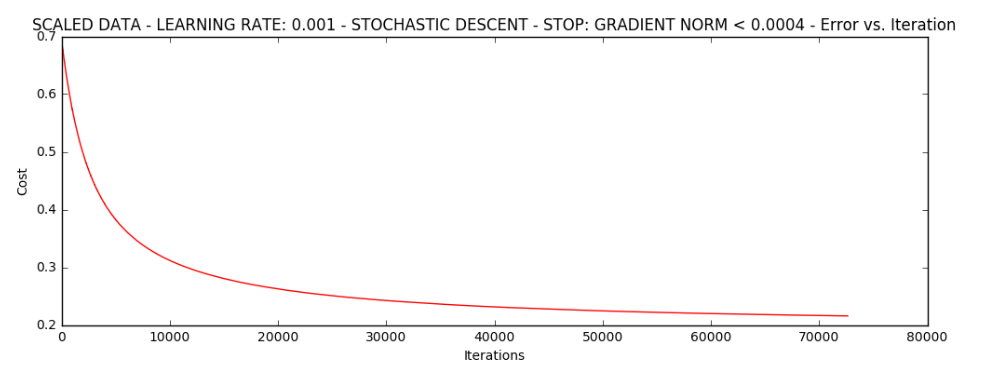
发现:随机梯度下降更快,但是我们需要迭代的次数也需要更多,所以还是用batch的比较合适!!!
runExpe(scaled_data, theta, 16, STOP_GRAD, thresh=0.002*2, alpha=0.001)
